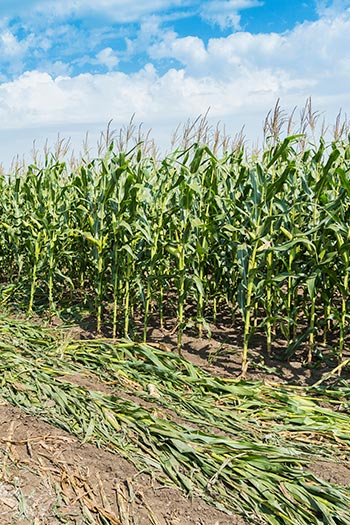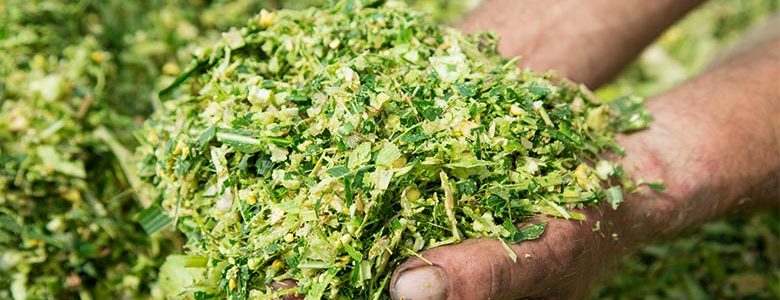- The Value of Shredlage® - September 12, 2016
Recent improvements in silage management strategies and available corn hybrid genetics have prompted dairy producers to grow more acres of corn and include higher levels of corn silage in dairy rations. There has also been a growing awareness in the importance of kernel processing when producing a high quality corn silage. The goals of processing corn silage are to create optimal particle size for rumen function, favorable grain particle form for effective use, and to improve fiber digestibility. One processing technique, shredlage, is gaining interest from dairy producers looking to increase the amount of corn silage in their dairy rations. This article describes the shredlage technology, examines current research using shredlage in dairy rations, and outlines the potential value of implementing the processing technique.
What is it? Shredlage Technology
Shredlage technology was developed by Ross Dale and Roger Olson in 2008 and allows for both increased theoretical length of cut (TLC) and increased kernel processing. shredlage is produced using a self-propelled forage harvester (SPFH) equipped with an after-market processor that features cross-grooved processing rolls set for a 1–2 mm gap and a greater roll speed differential (50% compared to the typical 21%). This unique processor longitudinally rips the forage apart, exposing the rind of the plant and increasing surface area available for microbial digestion, while simultaneously smashing the corn kernels. The TLC recommendation for shredlage is 26 mm with a target moisture of 65–67%. Kernel processing scores, measured as the percent of starch in corn passing through a 4.75 mm screen, are consistently above 70% after shredlage harvest, indicating optimum processing.
As of May, 2015, forage harvester manufacturer CLAAS offers the shredlage technology as a factory-installed or after-market option for JAGUAR Forage harvesters. Shredlage cannot be made with a regular kernel processor. This processing technology is being adopted by dairy producers with the goal of feeding higher forage diets to lower feed costs. Because corn silage digestibility is normally quite good, increasing the amount of corn silage in a ration previously meant an accompanying need to increase another effective fiber source. The increased TLC and particle size of shredlage yields a higher proportion of larger particles when particle size is evaluated using the Penn State Particle Separator. As long as no sorting occurs, this results in increased physically effective (pe) NDF of shredlage.
Does it work? Shredlage Research
Two research trials have been completed at the University of Wisconsin-Madison Arlington Agricultural Research Station to determine production responses of lactating dairy cows to rations containing shredlage.
UW-Madison Trial 1
 The first trial, Ferraretto and Shaver, 2012, determined the effects of feeding a TMR containing shredlage compared to conventional, kernel processed corn silage (KPCS) on intake, lactation performance, and total tract starch digestibility.
The first trial, Ferraretto and Shaver, 2012, determined the effects of feeding a TMR containing shredlage compared to conventional, kernel processed corn silage (KPCS) on intake, lactation performance, and total tract starch digestibility.
Half of a 20-acre field was harvested as shredlage using a Claas Jaguar self-propelled forage harvester equipped with shredlage processing rolls set for 30-mm TLC with the processor gap spacing set at 3-mm. The other half of the field was harvested as KPCS using a conventional self-propelled forage harvester set for a 19-mm TLC and equipped with conventional processing rolls set for a 3-mm gap spacing. Shredlage and KPCS were stored in separate 2.5-m-diameter silo bags at similar packing densities (272 kg of DM/m3). No silage inoculant was used. After a six week fermentation period, the feeding trial began in late October with 112 cows grouped by milk yield, DIM, breed (Holstein or Holstein-Jersey cross), and parity into 14 groups. During a 2 week acclimation period, all cows received a TMR containing a 50:50 mixture of shredlage and KPCS. For the following 8 weeks, cows received a TMR containing only shredlage (7 groups) or KPCS (7 groups). Rations were 50% corn silage (as shredlage or KP), 10% alfalfa silage, and 40% concentrate on a DM basis.
Nutrient composition was similar for TMR containing shredlage or KPCS. Corn silage processing score was greater for shredlage (75.0% compared to 60.3% for KPCS), suggesting greater kernel breakage at a longer TLC compared to KPCS. The proportion of coarse particles (percent of TMR retained on a 19-mm screen) was greater for shredlage (15.6% compared to 3.5% for KPCS). Feed sorting was minimal and did not differ between treatments. Dry matter intake (DMI) tended to be 1.5 lbs higher per cow per day for the shredlage group.
Fat-corrected milk (3.5% FCM) yield tended to be 2.2 lbs higher per day for the shredlage group with similar component yield and percent. Although not significant, fat yield was numerically increased for the Shredlage group. Energy-corrected milk (ECM) yield tended to be 2 lbs higher per day for the shredlage group. A significant treatment by time interaction for milk yield indicates maintenance of production level over time with shredlage. Shredlage increased total tract starch digestibility, potentially due to greater kernel breakage, and also increased ruminal in situ starch digestibility. Further analyses determined that in situ NDF digestibility was similar and fragility scores were similar between shredlage and KPCS rations, so the increased DMI is not from increased NDF digestibility.
UW-Madison Trial 2
The second trial, Vanderwerff et al., 2015, determined the effects of feeding BMR shredlage compared to KP BMR on lactation performance and starch digestibility. An additional comparison was made to BMR shredlage with chopped alfalfa hay.
One 47-acre field of a BMR hybrid was planted at the University of Wisconsin-Madison Arlington Agricultural Research Station. Half of the field, in alternating strips, was harvested as BMR shredlage using a Claas Jaguar self-propelled forage harvester equipped with shredlage processing rolls set for 26-mm TLC with a 2-mm roll gap. The same self-propelled forage harvester with a conventional Claas type processor was used to harvest KP BMR and was set for 19-mm TLC, 2-mm roll gap, and a higher roll speed differential (40%). BMR shredlage and KP BMR were stored in separate 3-m-diameter silo bags. The same inoculant was used for both BMR shredlage and KP BMR. After a 4.5 month fermentation period, the feeding trial began in late January with 120 Holstein cows grouped by milk yield, DIM, and parity into 15 groups. During a 2 week acclimation period, all cows received TMR containing conventional-hybrid shredlage. For the following 14 weeks, cows received TMR containing either BMR shredlage or KP BMR, or a third ration where part of the KP BMR was replaced with dry hay. The KP BMR with hay ration was used to evaluate the potential for shredlage as a source of peNDF.
Nutrient composition was similar for TMR containing BMR shredlage or KP BMR. Corn silage processing score was higher and showed less variation for BMR shredlage (72.4 ± 3.6% compared to 67.6 ± 6.5% for KP BMR), indicating both greater kernel breakage and more consistent processing for BMR shredlage. Feed sorting against large particles occurred in, and was similar among, all treatments. DMI was similar between all treatment groups. Over the course of the 14-week treatment period, milk yield of the BMR shredlage group was greater, or tended to be greater, by 2.6–3.3 lbs per cow per day than milk production of the KP BMR groups in 6 out of 14 weeks. Differences in milk production were more significant later in lactation where cows receiving BMR shredlage maintained higher milk production. Even with the increased TLC of BMR shredlage, there was no increase in milk fat or rumination time between treatment groups. Milk fat yield of cows receiving BMR shredlage was actually less than cows receiving KP BMR with hay, suggesting there may be no improvement in peNDF for shredlage.
Unpublished research
A trial completed at Cornell University (Chase, 2015) fed rations containing 50% corn silage (as either shredlage or KPCS), 14% alfalfa silage, and 36% concentrate on a dry matter basis. Silages were harvested at the same time from the same field using two different forage harvesters, one for shredlage and one for KPCS. Each silage was stored in a separate bunker silo for an eight-month fermentation period. For the lactation trial, 128 cows were divided in four pens (32 cows per pen) and fed either the shredlage or KPCS TMR. Rations were rotated between the pens every four weeks. Nutrient composition was similar for TMR containing shredlage or KPCS. The shredlage ration had a greater particle size with 34.1% retained on the top screen of the Penn State Particle Separator compared to 18.3% for the KPCS ration. Corn silage processing score for shredlage was 59.5 compared to 50.7 for KPCS. DMI (on a per-pen basis) did not differ. Milk yield and components were similar between treatments. In vitro starch digestibility was greater for shredlage (81.7% compared to 76.8% for KPCS).
A 12-week on-farm study was recently completed in New York in collaboration with Dairy One Forage Lab (Flis, 2016). Two pens of 152 cows received TMR containing 38% silage (either shredlage or KPCS), 48% concentrate, 13% haylage, and 1% whey. DMI was similar between treatments and feed sorting was not an issue. Milk production per cow per day was 2.2–3.2 lbs greater for cows receiving shredlage compared to the KPCS group. Percent retained on the top screen of the Penn State Particle Separator was greater for shredlage (36.8%) compared to KPCS (13.9%). Corn silage processing score was also greater for shredlage (62.2 ± 2.8) compared to KPCS (56.2 ± 4.0). Milk components did not differ between treatments. Additional research is planned to better define the differences between shredlage and KPCS, specifically between coarse and medium fraction starch and NDF, and potential correlations to milk production.
Should I use it? Potential Value
Adoption of shredlage technology is increasing and on-farm response is generally positive. Dairy producers adding shredlage to ration may be able to decreases added dry hay, straw, or whole cottonseed while increasing corn silage levels. Higher starch digestibility levels of shredlage may also allow for reduced amount of corn grain. Neither packing density nor feed sorting appear to be of increased concern with shredlage. As with conventional, kernel processed corn silage, longer chop length should be accompanied by higher moisture levels. Current TLC recommendations for shredlage are between 21-26mm. Increased fuel usage per hour has been reported as not noticeable or minimal. Up to 5% increase in fuel usage may be seen when processing dry material or when moisture levels exceed 65%. shredlage technology appears to be a valuable processing tool that can help producers maximize corn silage potential.
References
Chase, L. E. 2015. Shredlage in dairy cattle rations. Pages 215-220 in Cornell Nutrition Conference for Feed Manufacturers Proc., East Syracuse, NY. Cornell University Department of Animal Science, East Syracuse, NY.
Dale, R., R. Olson, and B. Scherer. “Shredlage—It’s All About the Cow!” Shredlage. http://www.shredlage.com. Accessed 15 June 2016.
Ferraretto, L. F., and R. D. Shaver. 2012. Effect of corn shredlage on lactation performance and total tract digestibility by dairy cows. Prof. Anim. Sci. 28:639-647.
Flis, S. 2016. Shredlage performance in on-farm research. Page 2 in Miner Farm Report, Chazy, NY. The William H. Miner Agricultural Research Institute, Chazy, NY.
Vanderwerff, L. M., L. F. Ferraretto, and R. D. Shaver. 2015. Brown midrib corn shredlage in diets for high-producing dairy cows. J. Dairy Sci. 98:5642-5652.
Shredlage is a registered trademark of Shredlage, L.L.C.

